Last updated:
The chances of success of the operation are increased if in the period that precedes a bond offering, the executive team of the Company carries a solid end-to-end planning process.
Successful Bond Offering candidates will begin the planning process in advance. The planning phase (as well as the preparation phase) will vary greatly dependent on several factors such as: the issuer´s development stage, if it is the first issuance or not, if you have a base Prospectus, if the Company will launch a Public or Private Offer and if you chose a regulated market or an MTF for listing.
In the Planning phase, the main aspects to be covered are (i) the Bond Offering Structure and main features; (ii) the Eligibility criteria; and (iii) the appointment of Advisors. The following sections will cover each one of these (click on the diagram to fast-travel to any specific caption).
4.1.1.1.1. Bond Offering Structure and main features
4.1.1.1.1.1. Strategic Options
How to know if a Bond Offering is the right strategy to achieve your goals?
Even if a Bond Offering is the final goal and your approach to raise funding, you should consider other financing options in the context of shareholder and corporate objectives.
These alternatives and a comparative analysis between them are available in section ‘2.1. How can your Company finance its funding needs?’.
With all the possible alternatives for raising financing, you’ll need a clear understanding of what’s required, how long the process will take, how much it’ll cost, and if alternative routes will need to be performed simultaneously.
What are the different types of corporate bond offers preceding the listing them?
When considering the possibility of offering bonds and having them traded on a stock market the Company should consider whether the issuance is going to be made by a Public Offer or a Private Placement.
A Public Offer is the process of distributing the Company’s bonds to the general public. Upon listing, the bonds are ready to be exchanged by investors. The transition to being a Company with bonds traded on the stock market is a relevant step as the Company will be under the public eye.
A Private Placement is the sale of bonds to a select group of investors and institutions and is seen as a private alternative for debt financing. Private Placement transactions and allow the Company to sell more sophisticated financial instruments because on the other side there are professional investors who understand the potential risks and rewards. One consequence may be less visibility for the Company (including media, clients and other stakeholders) and the potential lack of liquidity as the bonds will be held by a small number of investors.
4.1.1.1.1.3. What do investors look for/value in a bond issuance?
Prior to investing in a bond offering, investors will mainly focus on the current and future risk of the Company (namely the credit rating, if any, or the financial metrics, such as leverage and solvency ratios).
The bellow characteristics are valued by the investors:
Additionally, investors will also have into account what is the intended use of the proceeds (e.g. acquisitions, refinancing of existing loans or general corporate purposes), and what collaterals and guarantees can be offered, if any.
A Company may request the assistance of a financial intermediary to place the offer of bonds. The diagram bellow presents an overview of the typical considerations the financial intermediary will make, when assessing the financial ratios of the Company at the start of the offering process. The terms and pricing of the bond to be issued will be subject, to some degree, to negotiations between the Company and the financial advisor(s)/placement members.
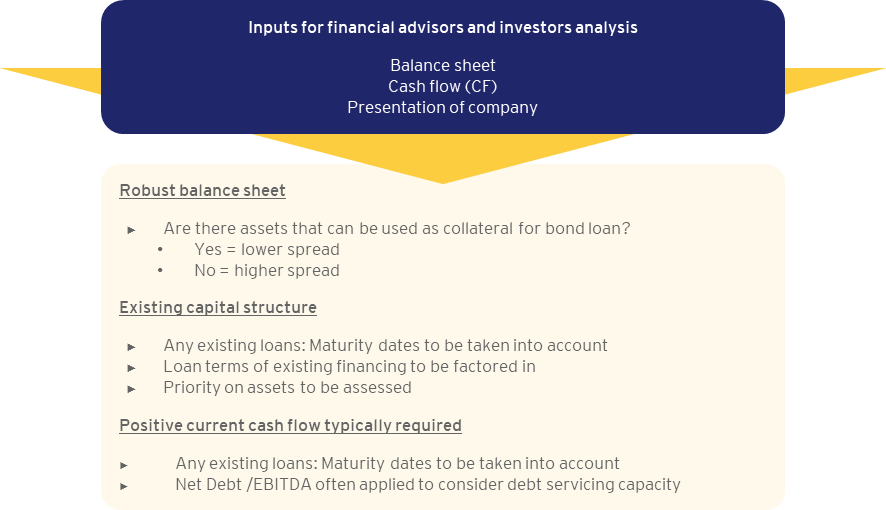
Is your company suitable to proceed with the issuing?
Prior to embarking on a bond issue, the Company must validate that there are no legal barriers to the issue. Accordingly, the Company should check that:
Additionally, if the bond issue is to be guaranteed by a parent company of the Issuer, similar questions need to be addressed in relation to the guarantor.
4.1.1.1.1.4. Structuring the bond
In the planning phase of a corporate bond offering, the Company should consider various factors when structuring the bonds to be offered. Examples of such factors are presented below:
Some relevant/common classifications
Standalone issuance vs. issuances under a program – a standalone bond issue is carried out independently, therefore, the Company achieves a financing transaction in one shot, which may be relevant, for instance, for a special project. The issuance is not integrated into a program.
If a Company needs several rounds of financing through a certain period of time, it may be easier to set up a programme for that purpose, instead of preparing each round independently. Euro medium term note (EMTN) programmes are the most common in Europe, allowing companies to issue and/or list bonds through an existing programme and base prospectus. The Company: i) will establish the framework of the bonds to be issued (main features) and will request approval of a base prospectus that will describe the framework applicable to such programme and the bonds to be issued. Each time the Company wishes to issue and/or list the bonds, the programme is already in place and a new prospectus is not required (updates to the base prospectus may be required).
This is an easy way to recurrently access market, plus allowing issuers to do so in several European markets, provided that the programme and base prospectus already contains such feature. Bonds issued under EMTN programmes generally have maturities of less than 5 years, being flexible in terms of interest rate (fixed/variable, other) and may be offered to the general public and/or institutional investors, as well as listing in regulated markets or MTF.
Green bonds – Green Bonds enable capital-raising and investment for new and existing projects with environmental benefits. The categories of potential eligible green projects include, but are not limited to, renewable energy, energy efficiency, sustainable waste management, sustainable land use, biodiversity conservation, clean transportation, climate change and climate adaptation. All companies that intend to issue a green bond usually submit an independent third-party external review. As a rule, to be accepted by the market, your report should usually be consistent with ICMA’s Green Bond Principles. To continue to be eligible for sustainable financing, issuers of green bonds must submit material information and reports regarding the current ‘ESG’ status of the bond(s) for filing. The Company must provide the Regulator and the stock market operator with any information that may cause the ESG bond(s) to no longer qualify, as soon as the Company becomes aware of such information.
Sustainability linked bonds – Sustainability-linked bonds aim to further develop the key role that debt markets can play in funding and encouraging companies that contribute to sustainability (from an environmental and/or social and/or governance perspective). Unlike Green Bonds, Sustainability linked bonds can be used to finance any corporate activity and their proceeds do not need to be allocated to specific projects. Notwithstanding, the Company commits to reaching determined measurable Sustainability Performance Targets around pre-determined KPIs, and to having these reviewed by an independent external party. Another core feature of this type of bonds is that the financial and/or structural characteristics of the bond can vary depending on whether the Company achieves the predefined sustainability objectives. As a rule, to be accepted by the market, your report should usually be consistent with ICMA’s Sustainable-Linked Bond Principles.
4.1.1.1.2. Eligibility criteria
You should have to consider the eligibility criteria of the markets your Company is considering listing its bonds, either a regulated market or an MTF, in Portuguese markets or abroad.
If your Company chooses to request admission to trading of bonds on a Portuguese regulated market or the MTFs managed by Euronext, the requirements for admission on each market are shown below:
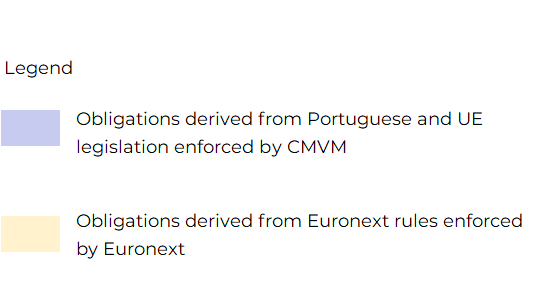
Issuer
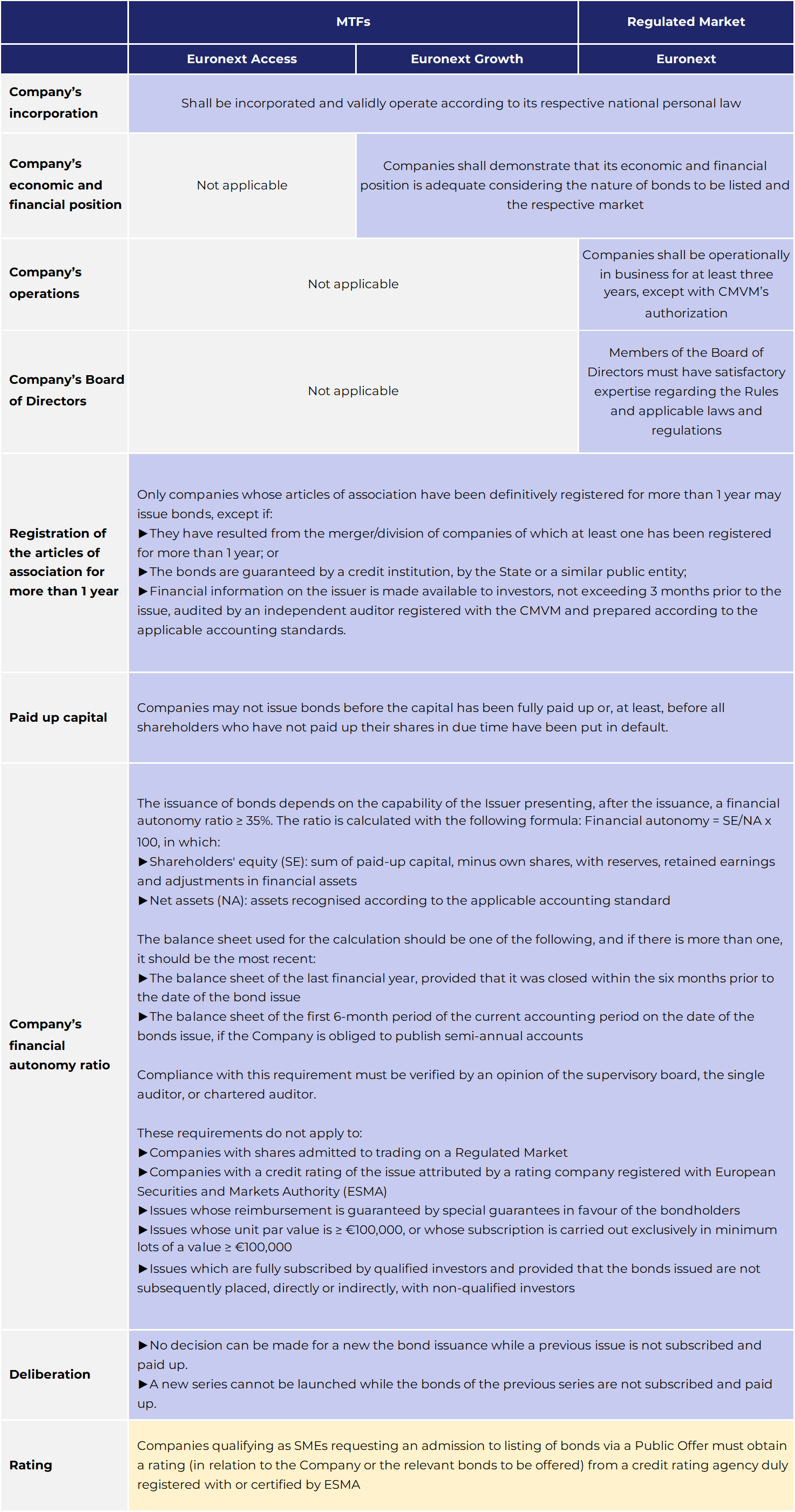
SMEs
Companies that have a market capitalisation of less than € 100 million (if listed) or according to their last annual or consolidated accounts meet at least two of the following three criteria: an average number of employees during the financial year of less than 250, a total balance sheet not exceeding € 43 million and an annual net turnover not exceeding € 50 million (if unlisted).
Offered bonds
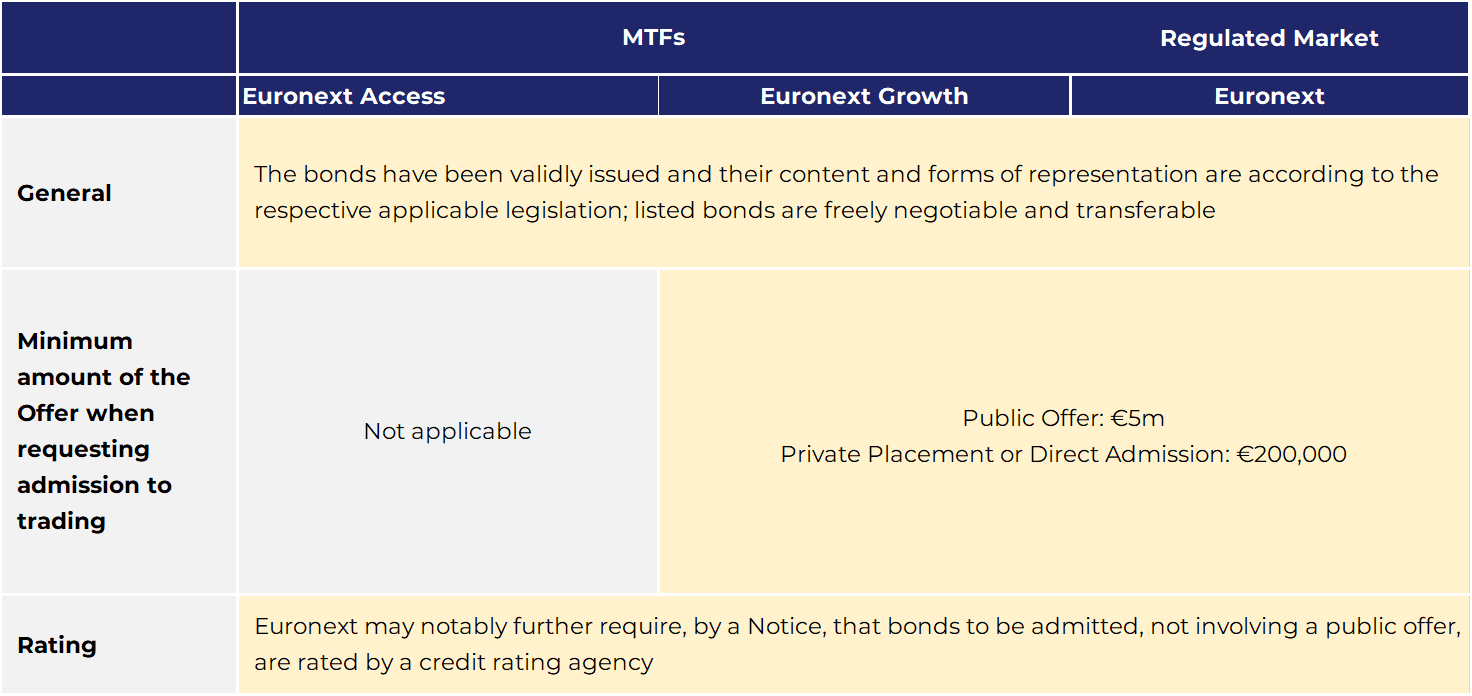
Listing process
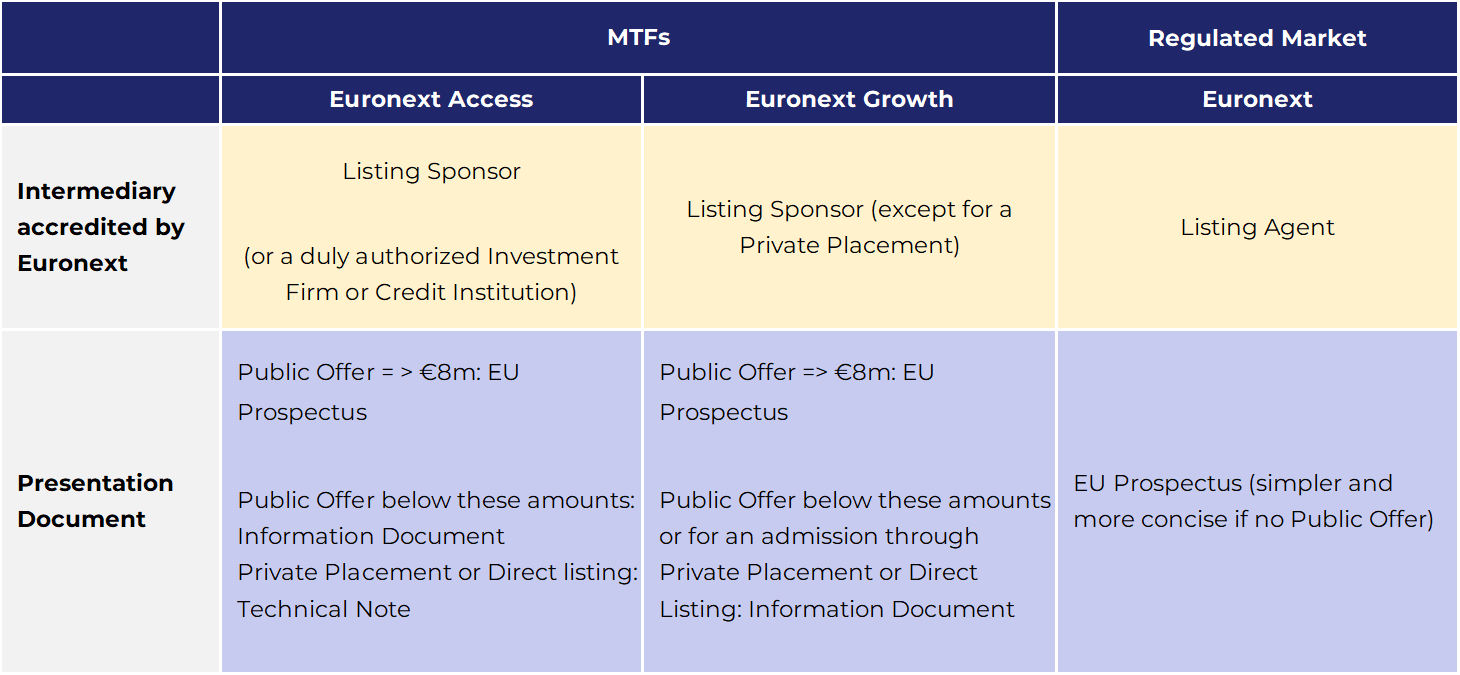
Financial information
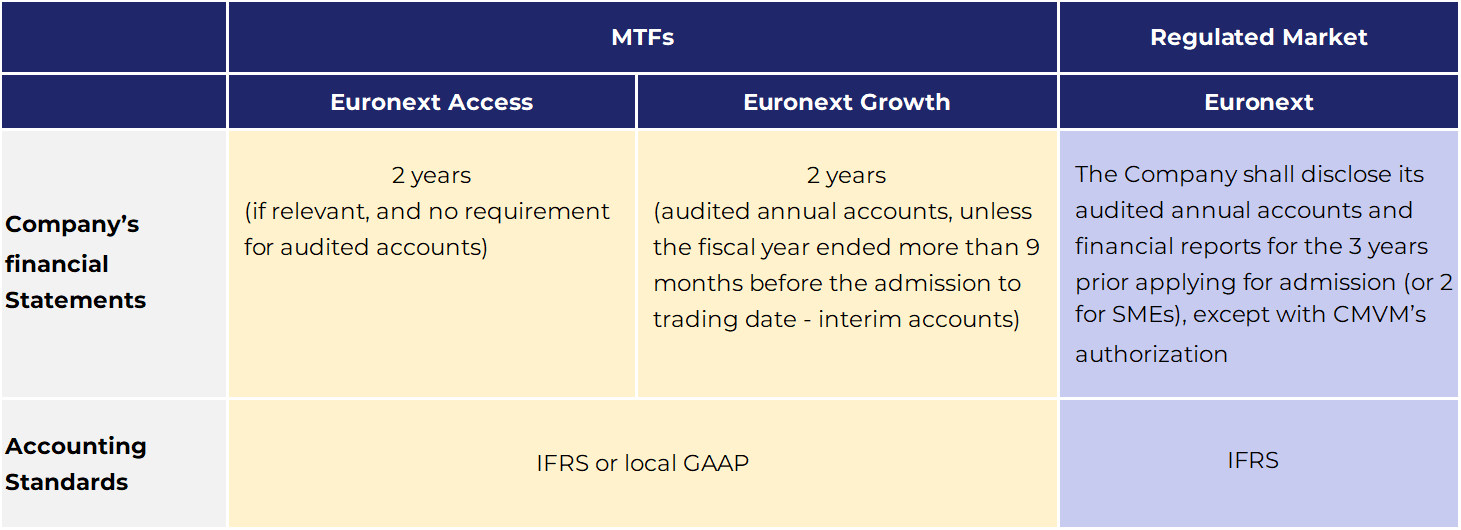
4.1.1.1.3. Appointment of advisors
Do you know who to ask for assistance in the Bond Offering process?
Besides the Company’s Management, advisors may typically have a crucial role in the Bond Offering process, for instance, by assisting with preparation of the documentation for the offering, ensuring that all the eligibility criteria are fulfilled, by managing the marketing and sale of the Company’s bonds and dedicating time to the analysis on how to ‘‘position’’ the Company to achieve a successful offering. Therefore, an experienced and motivated team will increase the likelihood of an orderly and professional offering process and a positive reception from investors.
What factors should companies consider when selecting advisors?
Track Record
Has the advisor been involved in successful Bond Offering processes? Does the legal advisor hold strong knowledge and practice in capital markets and industry specific legislation and regulation?
Reputation and Experience
Can the advisor provide special insights, advice, and research on the industry? Does the advisor have strong relationships with investors from the Company’s sector? Is the advisor perceived as credible by the capital markets?
Analyst Coverage
Do research analysts cover the industry and comparable companies (at national and international level)?
Distribution Strength
Does the advisor have solid distribution capabilities with retail and institutional investors? How effective is its retail sales force and its institutional sales force? Can the advisor reach regional, national or international?
Commitment to the Company
Will the advisor make the Company’s offering a priority?
Aftermarket Support
Will the advisor continue to advise the Company as a Company with publicly traded bonds and, when applicable, present it to potential investors?
The Company must dialogue with potential advisor candidates to measure how well they understand both the capital markets environment and, the Company and respective industry, and the aspects that investors will focus on in deciding whether to invest. To better decide between potential advisor, companies may test their knowledge regarding:
TIP
Advisors will not want to commit significant time and resources if they are not confident that the offering will be successfully completed. The number of the advisors approached depends partly on the attractiveness of your offering. If it is large and likely to attract larger firms, you may decide to approach more financial intermediaries. It is important, though, to inform potential advisors that you are approaching others..
Is a credit rating needed to proceed with an offering of bonds to the public?
Credit Rating
A credit rating refers to a quantified assessment of a borrower’s creditworthiness in general terms or with respect to a particular debt or financial obligation. Accordingly, the credit rating determines the ability of a company to fulfill its financial obligations within the defined deadline (i.e. likelihood a company will default or the credit risk carried by a debt instrument).
Credit assessment and evaluation for companies is performed by a credit rating agency. These rating agencies are paid by the Company looking for a credit rating for itself or one of its debt issues. A credit agency appraises the credit rating of a debtor by evaluating the qualitative and quantitative attributes of the Company in consideration. The information used in the referred appraisal may be obtained from internal information provided by the Company, such as audited financial statements, business plan, annual reports, as well as external information such as published news articles, analyst reports, overall industry projections and analysis.
A credit agency is not involved in the offering process, therefore, is considered to deliver an independent and unbiassed opinion of the credit risk carried by a specific company looking for to raise financing through a bond issuance.
It is not mandatory to have a credit rating to execute the bond offering and most of the debt issues do not present one. However, Companies may find it beneficial taking into account the specific conditions of the bond offering and the investors that will be targeted. For instance, having a credit rating may enhance the investors’ appetite for the offer as there are some institutional investors that may only invest on bonds with a rating attributed to it.
In addition, obtaining a rating may be a requirement for the admission to listing. According to Euronext Rulebooks, companies qualifying as SMEs (view definition in 4.1.1.2. Eligibility criteria) requesting an admission to listing of bonds via a retail offering / public offering are obliged to obtain a rating (in relation to the Company or the relevant bonds to be offered) from a credit rating agency duly registered with or certified by the European Securities and Markets Authority (ESMA), except if otherwise agreed by Euronext and the issuer.
ESMA accredit credit rating agencies may be found on this website: CRA Authorisation (europa.eu). Currently there are three credit agencies that control most of the overall ratings market: Moody’s Investor Services, Standard and Poor’s (S&P), and Fitch Group. The bigger agencies are normally more expensive than the smaller ones.


